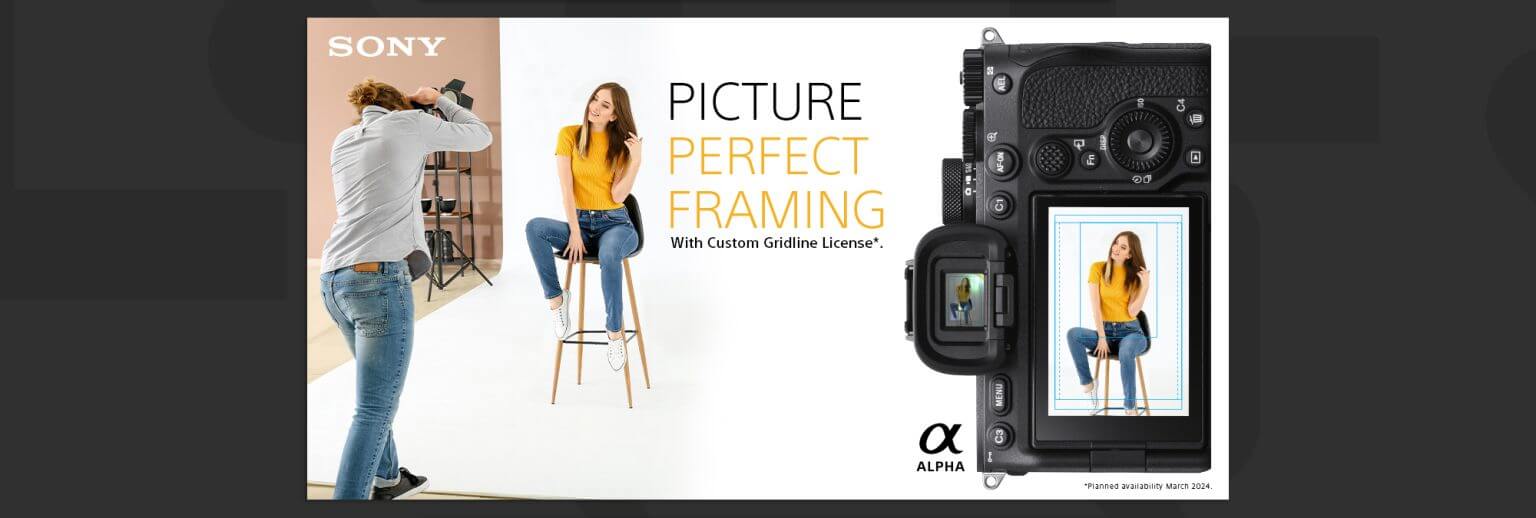SAN DIEGO – Nov. 28, 2023. Today, Sony Electronics announces a new custom gridline license planned for the Alpha 7 IVi in March 2024 onward, and more camera bodiesii in the future.
The new license offers the ability to import up to 4 customized original gridlines. The gridlines can be displayed on EVF (electronic viewfinder) and LCD (Monitor on the rear of the camera) when shooting which makes for easier, more consistent images. For example, staff at schools, photo studios, theme parks, cruise ships, malls, etc. will now have the ability to update their cameras with ease and utilize this tool for quick and precise, more professional shots. Imported customized gridlines are replaceable and color gridlines are available. Once gridlines are registered, it can be displayed with HDMI output as well. After shooting, users can check the images with the grid lines overlayed on EVF and LCD.
“The ability to import customized gridlines into a mirrorless camera is an essential feature for all of our photographers to capture images consistently,” says Frank Lombardo, National Photography Manager for Inter-State Studio and Publishing. “These simple gridlines keep head sizes the same for all our products and improve our production time. They also allow us to know where the edge of print will be during capture.”
“With a focus to improve both the consistency and quality of school photography, this advancement is a great foundation to a platform geared for volume photographers across the globe. Sony’s commitment to continually innovate along with their unparalleled support aligns perfectly with Strawbridge Studio’s, Inc. mission to provide the best picture day experience for schools across the country,” says Nic Davidson, Director of Photography of Strawbridge Studios, Inc.
“Sony’s commitment and support for this industry is unprecedented, from their support in student photography across the US to their training of future photographers and videographers and now, developing a camera system that will radically change the volume photography space for years to come,” says David Crandall, the Executive Director of School Photographers of America (SPOA).
“Now anyone can make a pattern, import it, then change and improve it to their liking. The possibilities are endless – simply rotate the four favorite patterns you need for the job at hand. Sony gives us real practical solutions, allowing the School, Sports and Volume Photography industry to produce better, more accurate compositions. The ability to import any four graphics, then scroll between them makes our jobs easier and results better than ever before,” says John Rak, member of the School Photographers Association of California (SPAC).
Not only can this be utilized as gridlines, they can also be used as partially filled transparency masks. In addition to school and sports photography, Sony has positioned this to be used for businesses such as cruise lines, theme parks, nature photography, ID photography, dentistry, and CG photography. Sony hopes that this custom gridline feature will help improve the creativity and work efficiency of photographers in a variety of industries.
The license will be available at a suggested retail price of $149 USD through the Upgrade and License Management Suite at https://ulms.sony.net as of Spring 2024.
Exclusive stories and exciting new content about all of Sony's other imaging products can be found at www.alphauniverse.com, a site created to educate and inspire all fans and customers of Sony α – Alpha brand.


You're getting great savings compared to before, rejoice!
Personally seen the great savings verbiage in the healthcare sector and it drives me nuts.
As a Canon photographer most of my life, prior to working with Sony on this we had mentioned the need for such items to Canon with little interest from their B2B reps and engineers. Hopefully Canon, Nikon, Fuji, Panasonic, etc. all decide this is worth exploring which will drive the cost down. But again, the cost is minimal to what it does for production purposes on the backend.
There's a grid on the R5 and I think most people can figure out how to use it without any help. I don't know about the other cameras.
It is tough to compare with that one.